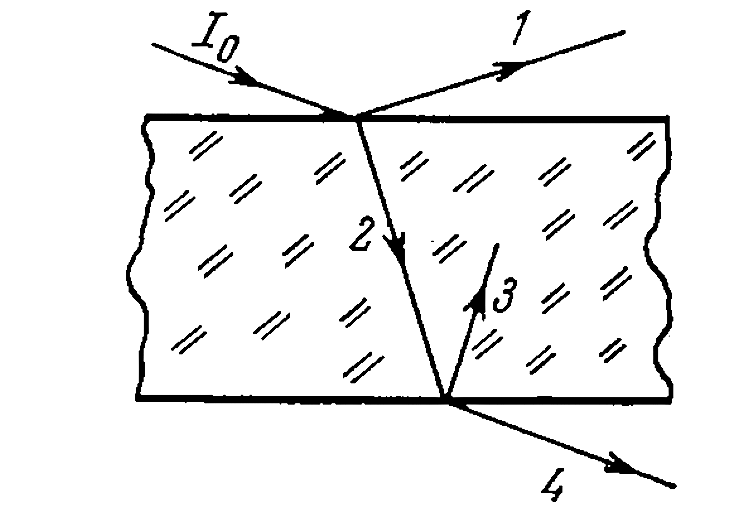A beam of natural light falls on the surface of glass at an angle of 45∘. Using the Fresnel equations, find the degree of polarization of
(a) reflected light,
(b) refracted light.
Here θ1=45∘
sinθ2=1√2×1n=23√2=√23=0.4714
θ2=sin−10.4714=28.1∘
Hence I'⊥=I⊥sin2(θ1−θ2)sin2(θ1+θ2)
=12I0(sin16.9∘sin73.1∘)2=12I0×0.0923
Thus I'∣∣=12I0(tan16.9∘tan73.1∘)2=12I0×0.0085
(a) Degree of polarization P of the reflected light
=0.08380.1008=0.831
(b) By conservation of energy
I''⊥=12I0×0.9077
I''∣∣=12I0×0.9915
Thus P=0.08381.8982=0.044
Topper's Solved these Questions
- BOOK - IE IRODOV, LA SENA & SS KROTOVCHAPTER - OPTICSEXERCISE - Dispersion And Absorption Of Light24videos
OPTICS
- BOOK - IE IRODOV, LA SENA & SS KROTOVCHAPTER - OPTICSEXERCISE - Optics Of Moving Sources22videos
OPTICS
- BOOK - IE IRODOV, LA SENA & SS KROTOVCHAPTER - OPTICSEXERCISE - Diffraction Of Light60videos
OPTICS
- BOOK - IE IRODOV, LA SENA & SS KROTOVCHAPTER - MECHANICSEXERCISE - Mechanics Problems92videos
MECHANICS
- BOOK - IE IRODOV, LA SENA & SS KROTOVCHAPTER - OSCILLATIONS AND WAVESEXERCISE - Electromagnetic Waves, Radiation36videos
OSCILLATIONS AND WAVES
Similar Questions
Natural light falls at the Brewster angle on the surfcae of glass. Using the Fresnel equations, find
(a) the reflection coefficient,
(b) the degree of polarization of refracted light.View SolutionA narrow beam of natural light falls on the surface of a thick transparent plane-parallel plate at the Brewster angle. Its top surface. Find the degree of polarization of beams 1−4 (Fig.)
 View Solution
View Solution
Knowledge Check
- Question 1 - Select One
A beam of light is incident on glass slab making an angle of 60∘ with the surface. The angle of refraction and the velocity of light in glass of R.I. 1.5 are
A19∘28,3×108m/sB29∘28',2×108m/sC19∘28',2×108m/sD29∘28,3×108m/s - Question 2 - Select One
Figure represents a glass plate placed vertically on a horizontal table with a beam of unpolarised light falling on its surface at the polarising angle of 57∘ with the normal. The electric vector in the reflected light on screen S will vibrate with respect to the plane of incidence in a
 A(a) Vertical planeB(b) Horizontal planeC(c) Plane making an angle of 45∘ with the verticalD(d) Plane making an angle of 57∘ with the horizontal
A(a) Vertical planeB(b) Horizontal planeC(c) Plane making an angle of 45∘ with the verticalD(d) Plane making an angle of 57∘ with the horizontal - Question 3 - Select One
A ray of light is incident on a glass slab at an angle of 45∘. If refractive index of glass be 1.6, what is the angle of refraction ?
A45.2∘B30∘C26.2∘D15.2∘
A narrow beam of natural light falls on a set of N thick plane-parallel glass plates at the Brewster angle. Find:
(a) the degree P of polarization of the transmitted beam,
(b) what P is equal to when N=1,2,5, and 10.View SolutionReflection of light and Refraction of light .
View SolutionReflection of light and Refraction of light .
View SolutionReflection of light and Refraction of light .
View SolutionUsing the Fresnel equations, find:
(a) the reflection coefficient of natural light falling normally on the surface of glass,
(b) the relative loss of luminous flux due to reflections of a paraxial ray of natural light passing through an aligned aoptical system comprising five glass lenses (secondary reflections o flight are to be neglected).View Solution

